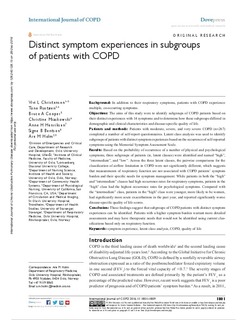| dc.contributor.author | Christensen, Vivi Lycke | |
| dc.contributor.author | Rustøen, Tone | |
| dc.contributor.author | Cooper, Bruce A. | |
| dc.contributor.author | Miaskowski, Christine | |
| dc.contributor.author | Henriksen, Anne Hildur | |
| dc.contributor.author | Bentsen, Signe Berit | |
| dc.contributor.author | Holm, Are Martin | |
| dc.date.accessioned | 2017-01-03T10:03:34Z | |
| dc.date.available | 2017-01-03T10:03:34Z | |
| dc.date.created | 2016-11-02T12:32:20Z | |
| dc.date.issued | 2016-08 | |
| dc.identifier.citation | The International Journal of Chronic Obstructive Pulmonary Disease. 2016, 11 (1), 1801-1809. | nb_NO |
| dc.identifier.issn | 1176-9106 | |
| dc.identifier.uri | http://hdl.handle.net/11250/2426112 | |
| dc.description | This is an open access article originally published in the International Journal of COPD. | nb_NO |
| dc.description.abstract | Background:
In addition to their respiratory symptoms, patients with COPD experience multiple, co-occurring symptoms.
Objectives:
The aims of this study were to identify subgroups of COPD patients based on their distinct experiences with 14 symptoms and to determine how these subgroups differed in demographic and clinical characteristics and disease-specific quality of life.
Patients and methods:
Patients with moderate, severe, and very severe COPD (n = 267) completed a number of self-report questionnaires. Latent class analysis was used to identify subgroups of patients with distinct symptom experiences based on the occurrence of self-reported symptoms using the Memorial Symptom Assessment Scale.
Results:
Based on the probability of occurrence of a number of physical and psychological symptoms, three subgroups of patients (ie, latent classes) were identified and named “high”, “intermediate”, and “low”. Across the three latent classes, the pairwise comparisons for the classification of airflow limitation in COPD were not significantly different, which suggests that measurements of respiratory function are not associated with COPD patients’ symptom burden and their specific needs for symptom management. While patients in both the “high” and “intermediate” classes had high occurrence rates for respiratory symptoms, patients in the “high” class had the highest occurrence rates for psychological symptoms. Compared with the “intermediate” class, patients in the “high” class were younger, more likely to be women, had significantly more acute exacerbations in the past year, and reported significantly worse disease-specific quality of life scores.
Conclusion:
These findings suggest that subgroups of COPD patients with distinct symptom experiences can be identified. Patients with a higher symptom burden warrant more detailed assessments and may have therapeutic needs that would not be identified using current classifications based only on respiratory function. | nb_NO |
| dc.language.iso | eng | nb_NO |
| dc.publisher | Dove Press | nb_NO |
| dc.rights | Navngivelse-Ikkekommersiell 4.0 Internasjonal | * |
| dc.rights.uri | http://creativecommons.org/licenses/by-nc/4.0/deed.no | * |
| dc.subject | COPD | nb_NO |
| dc.subject | chronic obstructive pulmonary disease | nb_NO |
| dc.subject | lungesykdom | nb_NO |
| dc.subject | helsefag | nb_NO |
| dc.subject | symptom experience | nb_NO |
| dc.subject | latent class analysis | nb_NO |
| dc.subject | quality of life | nb_NO |
| dc.subject | livskvalitet | nb_NO |
| dc.title | Distinct symptom experiences in subgroups of patients with COPD | nb_NO |
| dc.type | Journal article | nb_NO |
| dc.type | Peer reviewed | nb_NO |
| dc.rights.holder | © 2016 Christensen et al. | nb_NO |
| dc.subject.nsi | VDP::Medisinske Fag: 700 | nb_NO |
| dc.source.pagenumber | 1801-1809 | nb_NO |
| dc.source.volume | 11 | nb_NO |
| dc.source.journal | The International Journal of Chronic Obstructive Pulmonary Disease | nb_NO |
| dc.source.issue | 1 | nb_NO |
| dc.identifier.doi | 10.2147/COPD.S105299 | |
| dc.identifier.cristin | 1396550 | |
| cristin.unitcode | 217,7,2,0 | |
| cristin.unitname | Institutt for helsefag | |
| cristin.ispublished | true | |
| cristin.fulltext | original | |
| cristin.qualitycode | 1 | |

